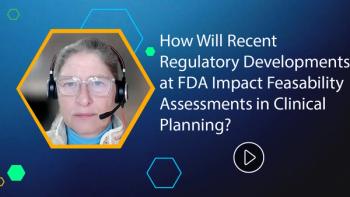
What Needs to be Done to Cover GLP-1?
In this part of his Pharmaceutical Executive video interview, Jim Shehan, chair of the FDA Regulatory practice, Lowenstein Sandler, discusses how the FDA and other regulators likely to respond to the increased public interest and potential off-label use of GLP-1 drugs, and what needs to be done for GLP-1s to be covered.
Based on your experience, how are the FDA and other regulators likely to respond to the increased public interest and potential off-label use of GLP-1 drugs? What potential oversight measures should companies and investors be prepared for?
Anytime a class of drugs becomes popular, and so widespread, FDA will and has a duty really to monitor it closely, to see what's going on with adverse reactions. Make sure that, you know, the known risks are being communicated and understood well. It is very interesting that, you know, you have a class of drugs here where 30, maybe 35% of people who start taking them don't continue because of the initial reaction reactions of nausea, etc. It's kind of leaked to the mechanism of action, you take these products, and you feel sick, or fall, you know, like you've eaten too much. So, for some people that never goes away, and they stop taking the product, for most it does.
So, FDA will communicate or make sure that the message is out there about issues related to safety. But that it would hearken back to what I was saying about products that are coming to the market afterwards, they will have a more significant task, if you know if they have a higher incidence of an adverse effect, or some new adverse effect that hasn't been seen with the other drugs in the class are already on the market. And FDA will look at that and may say, you know, why should we approve this drug? We have things out there that are already shown to be safe and effective. As a regulator, why should we take a chance with something that has a different or a greater incidence of adverse reactions?
What needs to be done for GLP-1 drugs to be covered?
So, on the insurance side, you know, right now you have a situation where if we're talking Ozempic, Wegovy, Mounjaro, and Zepbound. They have dual approvals. On the one hand they are approved for diabetes on the other hand with the different name they are approved for weight loss, and Medicare which drives a lot of the coverage. Just meaning that private Excuse me. Private insurers will often not cover something until Medicare does, Medicare won't cover the obesity usage. On the other hand, now the data is out there, you know, the significant study that Novo Nordisk did over a year showing that for non-diabetics, you take the product, and you get a lesser risk of major adverse cardiovascular events. That's driving a current discussion as to perhaps Medicare should be covering these products. And you have other benefits that are being associated. But there was some kidney data out there. Just this morning, I was reading about a real world study that showed Ozempic linked to a 30 to 40%, decreased use of alcohol use disorder. So, I think the data like that, and to a certain amount, public pressure will lead to greater coverage.
The one thing that makes me hesitant — remember, a number of years ago when hepatitis drugs came out that were a cure for a certain type of hepatitis. And it was kind of indisputable that they worked that they were pretty safe. But it was a one-time cost, and it was a high cost. And a lot of government players were an opposed to paying for them, because it even though it was going to reduce the overall spend to treat hepatitis that overall spend was spread out over years and years, you had one big upfront cost. And there was a lot of resistance. And a lot of states were slow to pay. Particularly, it's things like a prison population or in the Medicare Medicaid population. Ultimately, that went away, and everyone pays for the drugs. And you know, as a result, that scourge of the disease is the incidences fall into something very low in the United States. I think you may have a scenario like that playing out here. You have already seen rumblings of that. Governments wondering how they would pay, even if you just had, say your state workforce suddenly start taking GLP one weight loss drugs. It's a challenge.
Newsletter
Lead with insight with the Pharmaceutical Executive newsletter, featuring strategic analysis, leadership trends, and market intelligence for biopharma decision-makers.




